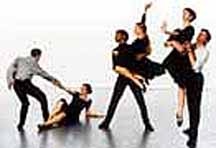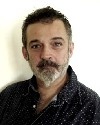Mark Morris in Conversation with Richard Dyer
Choreographer Discusses Upcoming Performances at the ICA
By: Erica H. Adams - Mar 16, 2007
The Institute of Contemporary Art series What New Is presents creative thinkers in conversation, a genre more common across the river in Cambridge, has now, successfully migrated. On March 7th, choreographer Mark Morris swayed across ICA's stage in a pashima shawl -part guru, part grandmother -to drink red wine and chat in his very funny, unpretentious manner with retired classical music Globe critic, Richard Dyer who drank San Pellegrino.
From May 15th -19th Mark Morris Dance Group returns to the ICA/Boston stage to present five performances of three acclaimed pieces from the group's repertory--"The Argument," "Candleflowerdance" "Grand Duo" and the world premiere of a new work set to Kyle Gann's "Studies for Disklavier."
"All vista" Morris said of the 'unusual' ICA/Boston stage's two glass walls displaying Boston Harbor views, there is "little room for live music or dancers." Problem solved: May's premiere is crafted for this stage, titled "Looky" and will have "live music" from a Disklavier. The "gallery situation" and "idea of watching" inspired the dance's title. Worried "looky" might be racist, Morris was assured by Oxford English dictionary, the informal mid 20th century exclamation "looky" is derived from 1875 "look ye".
Morris reminded the audience his dances are motivated by live music as dances by Paul Taylor's are by rhythm and Merce Cunningham's are by visuals. Recently, Mark Morris Dance Group's live music collaborations have included Indian composer Zakir Hussain, pianist Emanuel Ax and cellist Yo-Yo Ma. With live music, he said, you learn as you go.
Accommodating the small ICA/Boston stage and his need for "live" music, "Looky" will employ a Diskclavier, a player piano for the digital age with a readable disk. Introduced in 1987, this piano can replicate a pianist's live performance. Colin Nancarrow, who composed music solely for the player piano in Mexico City, was cited as a modern classical precedent.
Asked how he heard (or saw) music, he related Chopin to ballet, stated opera singer Maria Callas did not "move on the beat" and indicated his preference was for rhythmic surprise and oddities.
Morris's love of open-ended collaborations was best illustrated by the unintended result of his commissioning Lou Harrison to compose a work for piano, cello and percussion to dance to. "Rhymes with Silver" resulted: the composition was a "kit" of separate lines to be assembled by Morris. Each line, one for piano and one for percussion, could be played, omitted or doubled to finish in "G". Very John Cage. One of his many collaborations with composer John Adams since they were young, was opera's "Death of Klinghoffer" chorus written by Adams for Morris to dance to.
Does he dance anymore? Morris laughed "now I'm old, fat and tired?" Quickly rebounding with a straight line, he said the great thing about being a choreographer was being around young, talented dancers. Apprentices hired for a year, were "versatile, alive and alert" and did not dance on "automatic pilot." Fast "switch back curves" of his dances, he admitted, caused many lower leg accidents. Change, new perspectives, new people, new dances and what the young dance apprentices did, caused him to make-up new dances and continue.
The banter accelerated to a close with one-liners: the stage lighting design of James F. Ingalls made Morris feel good and "saved many shows". Given music, Morris could imagine the clothes dancers should wear. He's commissioned fashion designer Issac Mizrahi many times since Rameau's "Platee" (1998). Watching conductor James Levine comb his hair backstage, Morris said Levine only combed the outer-edges of his lion's mane halo. No doubt, this points the way for Morris's debut conducting the performance of "Gloria" at Brooklyn Academy of Music. Mark Morris Dance Group celebrates its 25th Anniversary with over 100 performances through 26 U.S. and ten U.K. cities with five world premieres, one at the ICA/Boston.
Morris (born 1956) grew up in Seattle where his mother introduced him to Balkan folk dance and ballet. Early in his career he worked with Lars Lubovitch, Hannah Kahn, Laura Dean, Eliot Field and the Koleda Balkan Dance Ensemble. In 1980, Morris formed his dance group in New York. Invited, in 1988, to become the national dance company of Belgium, Mark Morris Dance Group spent three years in residence at the Theatre Royal de la Monnaie in Brussels, then, returned to the USA, in 1991, as one of the world's leading dance groups. Since then, MMDG has performed across the USA and in major international festivals. In 1990, Morris formed the White Oak Dance Project with Mikhail Baryshnikov to choreograph and perform new dance. Since 1994, MMDG has created six works with the San Francisco Ballet.
A 2002 debut at the Mostly Mozart Festival at Jacob's Pillow Dance Festival in Becket, Massachusetts and the Tanglewood Music Festival (2002) has led to annual invitations to perform at both festivals.
In 2001, MMDG opened the Mark Morris Dance Center in Brooklyn, their first permanent headquarters in the USA which houses rehearsal space for the dance community, outreach programs for local children, and a school that offers dance classes for children of all ages. The company celebrates its 25th Anniversary this year.



